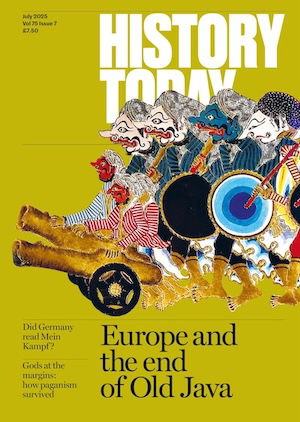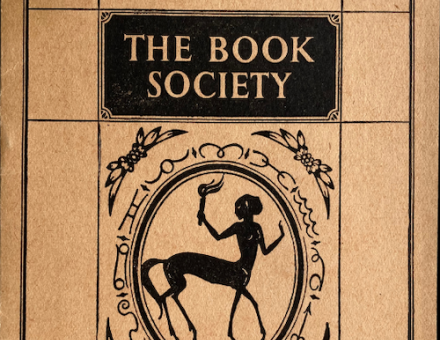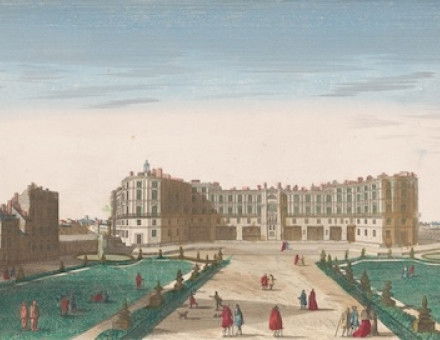The Long Shadow of the First Crusade
The First Crusade unleashed shockwaves felt across all of Christendom. New chapters to a story started in 1099 are still being written.

Called by Pope Urban II in Clermont in 1095 with the aim of taking Jerusalem and other Holy sites from Muslim control, the First Crusade culminated in the capture and bloody sacking of the Holy City on 15 July 1099. Fusing fervent devotion with savage military ferocity, the Crusade unleashed shockwaves that were far-reaching.
Its participants carved out four new Latin Christian states in the Holy Land. Known as the Latin East, the most important of them was the Kingdom of Jerusalem. Three of these states survived in one form or another until 1291. By fulfilling their aim of taking Jerusalem, the First Crusaders set a fateful precedent. In the centuries that followed, many more expeditions were carried out under the banner of the Cross. Some, like the First, targeted the Near East. Others were directed within Europe or at its peripheries. These campaigns would shape politics, culture and society throughout the Middle Ages and beyond. The violent conclusion of the First Crusade in 1099 set the tone for what followed.
Historians have long acknowledged that the First Crusade reconfigured Latin Christendom’s relations with both Byzantium and the Islamic world. Rather less attention has been paid to the immense impact it had within Latin Christendom itself. Stories from the expedition circulated widely over the next two centuries in both Europe and the Latin East. By about 1300 memories of the Crusade had become the focal point of a wide array of traditions. Some of these are still with us, often in forms that are not immediately apparent.
Early memories
The First Crusade fired the imaginations of Europeans. The spark that lit the touchpaper came from the crusaders themselves. Even before the capture of Jerusalem, letters and spoken reports recounting their exploits in the East had circulated around Europe. One letter, written for a general audience in the West at the behest of the expedition’s leaders in July 1098 (during the brutal and protracted Siege of Antioch), detailed the many battles that had already been fought. It ended with a plaintive request for all whom it reached to pray that the crusaders would prevail in the battles to come. The circulation of tales accelerated in the months following the capture of Jerusalem. Survivors of the expedition returned to their homes in Europe with stories about their adventures in the East. Some veterans, aware that the expedition had stimulated a surge of religious fervour in the West, sought very deliberately to use their newfound fame to advance their reputations and careers. Following his return, Count Robert of Flanders, one of the leaders of the expedition, became known as ‘Robert of Jerusalem’. When he arrived home, he brought relics and other sacred mementos gathered in the Holy Land. He presented one of these – an object revered as the arm of St George – to the abbey of Anchin, near Lille. During the carefully orchestrated ceremony arranged for its presentation, Robert regaled the monks with tales of his adventures.

Crusade veterans who remained in the Latin East were able to stimulate traditions about the expedition in their homelands from afar. In 1120 Ansellus, the cantor of the Church of the Holy Sepulchre in Jerusalem, sent a small piece of wood to his former congregation at Notre Dame in Paris. An accompanying letter indicated that it was a fragment of the Cross upon which Christ had been crucified. More than two decades after his departure on the First Crusade, he sent the relic in the hope that the monks of Notre Dame – both present and future – would remember him.
On the shoulders of giants
Although the ideology of crusading evolved considerably in the 12th and 13th centuries, the memory of the First Crusade remained a pivotal component of it. Participants in subsequent crusades were often familiar with the history of 1095-99. Occasionally, that knowledge shaped their own actions. This is apparent in the conduct of King Louis VII of France during the Second Crusade. Louis’ chaplain reportedly consulted written histories of the First Crusade before departing and may even have taken a copy of one with him to the East. At several points, when marching his army towards the Holy Land in 1147-48, the king made it clear that he did not wish to deviate from the route that the First Crusaders had taken 50 years earlier.
It was not by chance that the First Crusade resonated so strongly with participants in later campaigns. Its traditions were integrated into recruitment drives for subsequent calls to the Cross, featuring in sermons and letters. When Pope Eugenius III began mobilising the Second Crusade in 1145, he issued a recruitment letter that was largely framed around the memory of the First. He wrote about how his predecessor, Urban II, had inspired the First Crusaders to set out from Europe to capture the Holy Land. Eugenius then threw down the gauntlet, challenging the present generation to defend the territory conquered by their forefathers.

This challenge found renewed urgency after the Holy City and much of the Latin East fell to Islamic forces under Saladin in 1187. At Basel in 1201, Martin, abbot of the Cistercian abbey of Pairis – located not far along the Rhine from Strasbourg – gave a recruitment sermon for the Fourth Crusade. He addressed those who might be wary of participating for fear of the hostile powers that surrounded the Latin East, telling them to be mindful of the precedent laid down by the First Crusaders, who had in a flash cut a swathe through the Holy Land a century earlier. Martin’s message was clear: the First Crusaders had succeeded against greater odds than those facing the Fourth Crusaders.
In the Latin East the First Crusade’s participants were revered as founding fathers. The most hallowed were Godfrey of Bouillon, the first Latin ruler of Jerusalem, and his two immediate successors, his brother Baldwin I, and their relative Baldwin II. Sites that channelled their memory could be found throughout the Latin East, especially in Jerusalem itself. Near the Holy City’s Golden Gate was a graveyard where the crusaders who had been killed during the siege in 1099 were buried. The spot at the north-east corner of the city wall was marked by a large cross where they had breached it. That cross is shown in a detailed map of Jerusalem drawn in Cambrai around 1150, suggesting that Western pilgrims may have visited it, as they did other sacred sites such as the Church of the Holy Sepulchre and the Dome of the Rock. The date of Jerusalem’s capture came to shape how the inhabitants of the Latin East thought about history and their place in it. Within a few years, a religious feast was observed on its anniversary. Pivotal events during the 12th century – including the rededication of the reconstructed Church of the Holy Sepulchre in 1149 and the inauguration of Baldwin IV as king of Jerusalem in 1174 – were all held on 15 July. The memory of 1099 retained its potency long after its survivors had died.
The Nine Worthies
By the end of the 12th century, traditions surrounding the First Crusade were permeating aristocratic and royal courts in Europe. One reason for this was that it had become the focus of a body of chansons de geste, or ‘songs of deeds’. Composed in French and tailored to the tastes of Europe’s martial aristocracy, these songs were often performed at courtly gatherings. Around 1200 a trio of pre-existing chansons about the First Crusade were adapted into a cohesive trilogy. Together, they provided a romanticised narrative, presenting its participants as heroic Christian warriors. Later in the 13th century another series of chansons were written as prequels to the original trilogy. The new songs gave a fictionalised account of the ancestry and early life of Godfrey of Bouillon, by now emerging as the First Crusader par excellence. They cast Godfrey as the descendant of a powerful warrior who appears from a mysterious realm in a boat pulled by a swan. Tales about this warrior – known as the Swan Knight – proved particularly influential in German-speaking Europe, inspiring works that included Wolfram von Eschenbach’s Parzival.

Godfrey of Bouillon’s posthumous fame attained new heights in the early 14th century when he was enrolled into the Nine Worthies, a pantheon of famous warriors thought to epitomise the ideals of chivalry. The roster divided neatly into three sets of three. Hector, Julius Caesar and Alexander formed a triad of ‘pagan’ heroes, while Joshua, David and Judas Maccabeus made up a trio of Biblical warriors. Godfrey, along with King Arthur and Charlemagne, featured as Christian heroes.
The First Crusade fascinated European elites in the Middle Ages. Between 1250 and 1252 King Henry III of England commissioned four separate wall paintings depicting the Siege of Antioch, planned for the Queens’ Chamber in Westminster Palace and rooms in the Tower of London, Winchester Castle and Clarendon Palace. King Charles V of France owned a number of books about 1095-99; an inventory made in 1273 records that they were stored in the Royal Library at the Louvre Palace. In 1378 Charles hosted a lavish banquet in Paris in honour of the visit of his uncle, Emperor Charles IV. As the monarchs dined, members of the court re enacted the First Crusaders’ Siege of Jerusalem around them. Performers used siege towers to clamber up a replica of the Holy City’s walls, providing comic relief by tumbling to the ground. In the 15th and 16th centuries members of the ducal House of Burgundy owned tapestries that depicted the First Crusade’s key moments. At a banquet hosted by Philip the Good in Lille in 1454, one courtier made a dramatic entrance dressed as the Swan Knight, before proceeding to challenge the assembled guests to joust against him.
Modern times
In the era following the Middle Ages the memory of the First Crusade evolved simultaneously with new values and ideas. In the late 16th century Torquato Tasso wrote Jerusalem Delivered, an epic poem in Italian. Composed in the wake of the Battle of Lepanto in 1571, the poem arguably says more about the deepening conflict between Europe and the expanding Ottoman Empire than it does about the Crusade. Nevertheless, Tasso’s opus was phenomenally popular in the centuries that followed. It was translated into several languages, with Edward Fairfax dedicating his English version, produced in 1600, to Elizabeth I.
In the 19th century – the age of Romantic nationalism – some European countries began to look to the Crusades for figures from the past who could bolster feelings of national identity. In 1843 King Louis-Phillippe of France unveiled the Salles des Croisades at Versailles, a suite of rooms featuring dozens of paintings devoted to the First Crusade, as well as other figures and events from crusading history. In 1848 a monument to Godfrey of Bouillon, funded by the Belgian state, was unveiled in Brussels; a statue of Urban II was erected in Clermont 50 years later.

The Crusade’s traditions have permeated European culture in more subtle ways, too. In 1850 Richard Wagner completed his opera Lohengrin, using legends of the Swan Knight as the basis of its narrative. The ‘bridal chorus’ – a piece that Wagner wrote to accompany a scene in which a marriage ceremony takes place – is still played at weddings, known in English as ‘Here Comes the Bride’. At an international conference on tuberculosis hosted in Berlin in 1902, a doctor from Paris suggested that since the battle against the disease was akin to a crusade, they should adopt as a symbol the Cross of Lorraine, which had supposedly adorned the banner of Godfrey of Bouillon.
A taste of history
The impact of the First Crusade endures today. Baldwin I appears as a character in Crusader Kings II (2012), the second instalment of a popular video game series. Visitors to the small town of Bouillon in the Belgian Ardennes can stay at the Hotel Relais Godefroy or enjoy a glass of the local beer Godefroy, which promises those who sample it un goût d’histoire, or ‘a taste of history’. As curious as these cameos may seem, by conscripting figures like Godfrey and Baldwin I to serve the needs of the present, they belong to a rich tradition that stretches back over nine centuries.
Simon John is Senior Lecturer in Medieval History at Swansea University.






